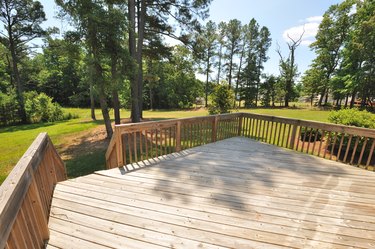
The ease of cutting, shaping, and painting or staining plus the stability of the finished project makes wood the preferred product whether building furniture or houses. When choosing pressure-treated versus untreated lumber, consider the use of the lumber and whether it is for the interior or exterior of the home. Cabinets, furniture, and items that will be painted or stained are constructed of untreated lumber, while pressure-treated lumber is used in construction and a variety of exterior projects.
About Untreated Wood
Video of the Day
Untreated lumber is air- or kiln-dried. The moisture in the lumber is removed by air circulation between the boards. Untreated wood is cut into boards and then stacked with stickers or consistently cut thin boards between the layers to allow air circulation. After the moisture content of the air-dried lumber is reduced to 25 percent, then it may be kiln-dried to a moisture content of approximately 8 percent to complete the drying process.
Video of the Day
Woodworkers often prefer air-dried lumber. According to these craftspeople, air-dried woods are easier to work and are true to the wood's original color. Air-drying can take significantly longer than kiln-drying, which is a factor when preparing wood for building fine furniture or framing a house. A craftsperson may have the time, but the pressures of the construction industry require a faster process, resulting in kiln-drying large quantities of lumber.
Whether air- or kiln-dried, untreated wood must be dried to a point of 15 to 20 percent moisture content. Then, once on-site and indoors, the lumber continues to dry until it reaches the equilibrium moisture content, where it is stable in the indoor environment and no longer absorbs or loses moisture from the atmosphere.
About Pressure-Treated Wood
Pressure-treated wood has been soaked in chemical solutions to increase its resistance to insects and decay. The lumber is placed in a tank and undergoes a process that replaces the air in the wood with the preservative. This process leaves the wood "wet," making it difficult to paint. Pressure-treated lumber is used in outdoor projects where the insect and decay resistance ensures the long life of the decking boards, pergola, or other structure.
The three primary treatments used in pressure-treated construction lumber are borate; rot-resistant treatments, like alkaline copper quat (ACQ); and non-combustible (Non-Com). Borate is wood treated with disodium octoborate tetrahydrate (DOT). The main ingredient in DOT is the mineral salt boron, which protects the wood against decay, fungi, Formosan termites, and other insect species. The borate treatment does not contain arsenic, which has been a concern for many consumers.
ACQ is another environmentally friendly preservative used in treating lumber. The water-based preservative consists of copper and a quaternary ammonia compound; it doesn't contain arsenic or chromium. Non-Com pressure-treated lumber is infused with fire-retardant chemicals, which results in the fire-heated lumber releasing water and carbon dioxide from the wood cells to slow and/or stop the spread of the fire.
Uses of Untreated Wood
Untreated wood easily accepts paint or stain, making it ideal for interior uses. Interior doors, fine furniture, hardwood flooring, paneling, cabinets, and other wood items are made of untreated air- or kiln-dried woods. It is just as strong as pressure-treated wood and is easier to cut, drill, and glue. Untreated wood is available in a wide range of sizes, from quarter-round trim to 6x6 nontreated dimensional lumber suitable for framing and furniture projects.
Indoors or out, use untreated wood if the material will be in regular contact with humans, pets, or food. Apply stain, paint, polyurethane, or natural wood treatments, such as vegetable-based oil, shellac, or wax products, to protect untreated wood from day-to-day life. The effects of water on untreated lumber can be devastating, causing warping and staining and otherwise damaging the bare wood.
Uses of Pressure-Treated Lumber
Pressure-treated lumber is used in a wide range of construction and outdoor projects where there may be direct contact between the wood and the soil or other moisture-laden surfaces. From fence posts to retaining walls to decks to the sill plate that connects your house frame to the concrete foundation, all require pressure-treated lumber to prevent decay and insect infestations that would result in the untimely rotting and destruction of the wood.
In fire-prone areas, Non-Com treated lumber helps reduce the damage of fire to homes and other structures. It won't completely eliminate the possibility of fire, but it slows the progression of the flames.
When using pressure-treated lumber, protect yourself from the infused chemicals by wearing gloves, safety goggles, and a dust mask when handling, cutting, drilling, or hammering the wood. While current treatments do not incorporate arsenic, chromium, and other extremely hazardous elements, the chemicals are not safe for human or animal exposure.